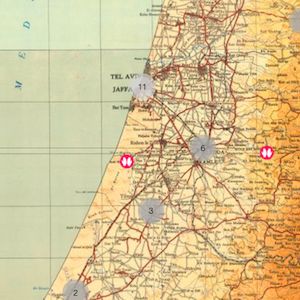Palestinian Oral History Map
The Palestinian Oral History Map is a ground-breaking cartographic exercise that maps out the memories and experiences recounted by survivors of al-Nakbah [lit. catastrophe], the forced displacement of over 700,000 Palestinians in the wake of the Palestine War (1947-1949). Drawing from thousands of hours of interviews from the Palestinian Oral History Archive (POHA), the map provides a stunning visual representation of Palestine in the 1940s, bringing interviewees’ memories of their lost homeland to life.
Available in English and Arabic, the website has three sections: ‘Map/Timeline’, ‘About’, and ‘Related Projects’. The latter provides external links to the map’s main sources and backers, namely the Palestinian Oral History Archive from which the points of interest located on the map were drawn from, Palestine Open Maps which supplied the historical maps that formed the basis of the digital map, and Visualising Palestine which is the overarching project behind both Palestine Open Maps and the Palestinian Oral History Map. ‘About’ launches a pop-up window that provides instructions on navigating the map and timeline, lists production credits, and highlights some of the project’s limitations.
The ‘Map/Timeline’ section is where the bulk of the action is, with visitors being able to switch between the map program or a detailed timeline outlining major events during the Palestine War. Clicking on entries in the timeline brings up the relevant list of interviews from the POHA though it should be noted that the interviews are not embedded into the Palestinian Oral History Map website but rather are links to their corresponding page on the POHA archive. The map itself is the major landmark of the website, allowing intrepid historians and geographers to navigate and explore 264 points of interest which include towns and villages, cultural sites, monuments, places of worship, public institutions (e.g. universities, airports, ports, schools), private institutions (in this case, the Egged Bus Company and the King David Hotel), and major landscape features. Visitors are able to apply filters to include or exclude particular landmarks and can also switch on an overlay of roads that run through modern-day Israel and Palestine. They can also alternate between historic maps from the 1940s and satellite imagery from 2019 as the base map layer. Both are visually arresting but the former perhaps more so as it represents the product of the development team compiling over two hundred ordnance surveys produced by the British Mandate Survey of Palestine.
As the project website identifies, one of the potential limitations is the issue of language. While the map and timeline are available in both English and Arabic, the oral history interviews they link to are available only in Arabic, which might present a problem in more generalist courses where proficiency in Arabic is not a requirement. Nevertheless, there are still a number of interesting ways that the map can be deployed in the classroom. In the first instance, teachers can develop a module tracking changes in Israel/Palestine over time, either through switching between the historic maps and satellite imagery—as well as turning the road overlay on or off—or by combining it with other cartographic material freely available such as Google Maps or OpenStreetMaps. Alternately, in more advanced settings, students could be asked to, in effect, create their own map of al-Nakbah as part of a mapping and research exercise by combining the historical base map (with all points of interests turned off) with external primary and secondary source materials they would have to locate.
While not a comprehensive list of every location mentioned in POHA interviews or of historical significance in general, the project is nevertheless a wonderful contribution to efforts to keep Palestinian history alive. The idea of visualising oral history interviews and mapping the spaces and places important to interviewees is a rich and productive exercise and the Palestinian Oral History Map serves as an excellent model of how to do so.
